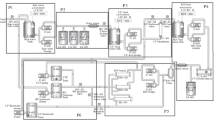Abstract
In this work considered the problem of safety analysis of control mechanisms in modern information systems, including control software systems of cyberphysical and industrial facilities, digital control systems for distributed cyber environments VANET, FANET, MARINET, industrial Internet of things and sensor networks. The representation of security violation as a property of the system described by a complex function is proposed, in which the method of finding violations is described in the form of approximation of that function and the calculation of its values for specific systems. Various approaches to the interpolation of such function are considered in the work, it is shown that the most promising option is the use of deep neural networks.


Similar content being viewed by others
REFERENCES
Kalinin, M.O., Krundyshev, V.M., and Semianov, P.V., Architectures for building secure vehicular networks based on SDN technology, Autom. Control Comput. Sci., 2017, vol. 51, no. 8, pp. 907–914.
Kushik, N.G., Mammar, A., Cavalli, A., Yevtushenko, N.V., Jimenez, W., and Montes de Oca, E., A SPIN-based approach for detecting vulnerabilities in C programs, Autom. Control Comput. Sci., 2012, vol. 46, no. 7, pp. 379–386.
Godefroid, P., Microsoft Research, Fuzzing, Microsoft—A Research Perspective, ACSC 2017.
Pechenkin, A.I. and Nikolskiy, A.V., Architecture of a scalable system of fuzzing network protocols on a multiprocessor cluster, Autom. Control Comp. Sci., 2015, vol. 49, no. 8, pp. 758–765.
Poosankam, P., Pfenning, F., Platzer, A., Brumley, D., and McCamant, S., Scaling concolic execution of binary programs for security applications, PhD Thesis, Carnegie Mellon University, 2013.
Hornik, K., Stinchcombe, M., and White, H., Multilayer feedforward networks are universal approximators, Neural Networks, 1989, vol. 2, no. 5, pp. 359–366.
Hastad, J., Computational Limitations of Small-Depth Circuits, Cambridge, MA: MIT Press, 1987.
Yoshua Bengio, Learning deep architectures for AI, Found. Trends Mach. Learn., 2009, vol. 2, no. 1, pp. 1–127. http://dx.doi.org/.10.1561/2200000006
Bengio, Y. and LeCun, Y., Scaling learning algorithms towards AI, in Large Scale Kernel Machines, Bottou, L., Chapelle, O., DeCoste, D., and Weston, J., Eds., MIT Press, 2007.
Rumelhart, D.E., Hinton, G.E., and Williams, R.J., Learning representations by back-propagating errors, Nature, 1986, vol. 323, pp. 533–536.
Szegedy, C., et al., Going deeper with convolutions, 2015 IEEE Conference on Computer Vision and Pattern Recognition (CVPR), Boston, 2015, pp. 1–9.
Alemi, A.A., Ioffe, S., Szegedy, C., and Vanhoucke, V., Inceptionv4, Inception-ResNet and the impact of residual connections on learning, AAAI, 2017, vol. 4, p. 12.
Aliaksei, S. and Moschitti, S., Learning to rank short text pairs with convolutional deep neural networks, SIGIR’15 Proceedings of the 38th International ACM SIGIR Conference on Research and Development in Information Retrieval, 2015, pp. 373–382.
Ng, A.Y., et al., Deep Speech: Scaling up end-to-end speech recognition, Presentation from a SF Meetup hosted event at NVIDIA (October 6th, 2015).
Graves, A., Wayne, G., and Danihelka, I., Neural Turing Machines, 2014. http://arxiv.org/abs/1410.5401.
Hinton, G.E., To Recognize Shapes, First Learn to Generate Images, Tech. Rep. UTML TR 2006-003, University of Toronto, 2016.
Erhan, D., Manzagol, P.-A., Bengio, Y., Bengio, S., and Vincent, P., The difficulty of training deep architectures and the effect of unsupervised pre-training, Proceedings of The Twelfth International Conference on Artificial Intelligence and Statistics (AISTATS’09), 2009, pp. 153–160.
Srivastava, N., et al., Dropout: A simple way to prevent neural networks from overfitting, J. Mach. Learn. Res., 2014, vol. 15, no. 1, pp. 1929–1958.
ACKNOWLEDGMENTS
The project results are achieved using the resources of supercomputer center of Peter the Great St. Petersburg Polytechnic University – SCC “Polytechnichesky” (www.spbstu.ru).
The project is financially supported by Ministry of Science and Higher Education of the Russian Federation, Federal Program “Researching and Development in Priority Directions of Scientific and Technological Sphere in Russia within 2014–2020” (Contract no. 14.575.21.0131, September 26, 2017, the unique identifier of the agreement RFMEFI57517X0131).
Author information
Authors and Affiliations
Corresponding authors
Additional information
The article was translated by the authors.
About this article
Cite this article
Demidov, R.A., Pechenkin, A.I., Zegzhda, P.D. et al. Application Model of Modern Artificial Neural Network Methods for the Analysis of Information Systems Security. Aut. Control Comp. Sci. 52, 965–970 (2018). https://doi.org/10.3103/S0146411618080072
Received:
Published:
Issue Date:
DOI: https://doi.org/10.3103/S0146411618080072




